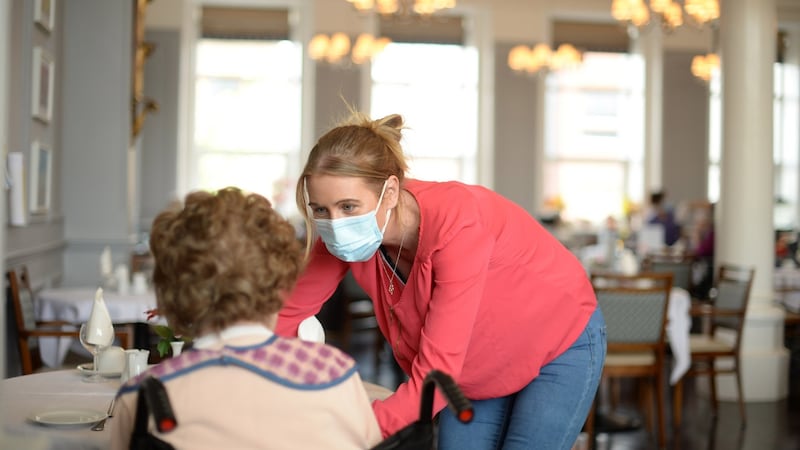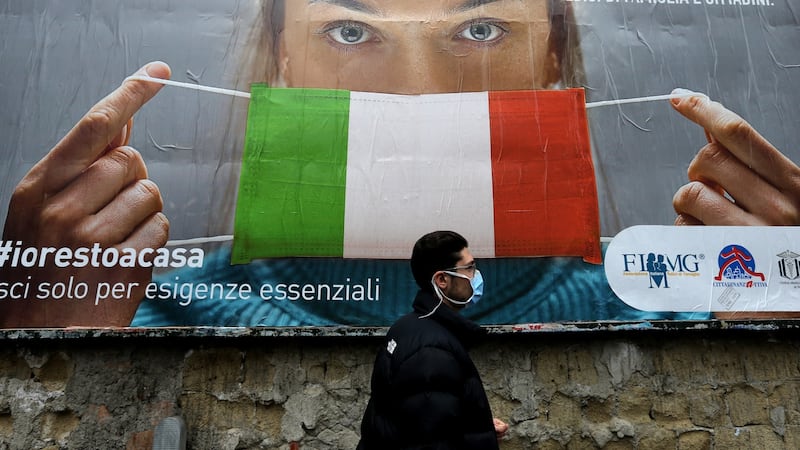It has been compared to a marathon, but the struggle with Covid-19 in 2020 has been more like an energy-sapping form of ultra-running.
First, you run a marathon that stretches your abilities and strips you of your reserves - our first wave of the disease. Then, you run another marathon, one that almost brings you to your knees - the second wave. And then, after two full rounds at full pelt, you have to stagger on some more, before the finishing line comes into view.
This Christmas, our Covid fates hang in the balance: will the vaccines for the virus bring us to the finishing-line of the pandemic quickly, or could we still have a way to run?
You have to go back to January 14th for the first mention of coronavirus in The Irish Times this year, in a report about a visitor to Thailand infected with a new strain of virus linked to a "pneumonia outbreak" in China.
By February 11th, the disease from the coronavirus had been given a name - Covid-19 - and the World Health Organisation was warning it posed "a very grave threat for the rest of the world".
We all know - have it seared into our memories - what happened then. The first case in Ireland on February 29th. The first death on March 11th. The succession of lockdown dates, each one announced by then Taoiseach Leo Varadkar in a hauntingly empty Government Buildings. The closure of shops, offices, schools. Hospitals stretched to capacity, despite closing their doors to normal activity. The death toll in our nursing homes and care facilities.
Faced with a once-in-a-lifetime emergency, Ireland's system quickly reorganised itself with little respect for long-standing demarcations or vested interests
In the summer, the virus left to cause havoc in other parts of the world while we in Ireland breathed a sigh of relief. We got used to a “new normal”, a watchful, constrained existence, but still the disease came back. More lockdown, more economic devastation followed in the autumn, and yet, by the end of the year, there was no clear outcome to the race.
This too will pass, people said at the beginning of it all. The cliché is still true, even if the virus is providing a more stubborn foe than we might have imagined at first.
Covid-19 has wreaked a very precise form of devastation, focused on the very old and vulnerable. That is why it has caused so much disruption, with a large proportion of the population not at any great risk but capable of passing it on to those who are.
It is “not the Black Death”, as veteran journalist Mary Kenny remarked during the year. But neither is it as benign as the flu, as lockdown critics have claimed.
This was the year in which Ireland’s much-maligned health service stepped up to the plate. Faced with a once-in-a-lifetime emergency, the system quickly reorganised itself with little respect for long-standing demarcations or vested interests. Staff moved freely across specialities to help out in the areas of greatest need. Distinctions between public and private medicine were temporarily set aside.
Traditional objections to technology were abandoned; tele-medicine, for example, was developed within weeks, after years when we were told it could not be done.

Electronic prescriptions also became a near-instant reality, leading doctors and patients to ask why this hadn’t happened long ago.
Health workers paid a significant price for their heroics, with more than 12,000 cases and eight deaths, not to mention the months of long, exhausting shifts put in by frontline staff, often spent cased in protective layers of plastic and latex.
A new command structure emerged, led by chief medical officer Dr Tony Holohan and his fellow members of the National Public Health Emergency Team (Nphet). For months, as politicians wrangled over the formation of a new government, it seemed as though Nphet was running the country. For months, too, we "followed the science," until the science stopped saying things that people wanted to hear, and scientists stopped agreeing about the way forward.
So how did we do? Any assessment is subject to caveats. We were learning on the hoof; so was everyone else. Even today, so much about the virus remains uncertain. We’re still not sure to what extent people with no symptoms can spread the disease, for example. Or how significant transmission by aerosols (tiny droplets in the air) is in driving transmission. Advice on masks and social distancing was written, and re-written, and is still not set in stone. We don’t know yet if vaccines will be the miracle cure we need.
The early failings are well documented: how we erred in letting in Italian rugby fans in March; the failure to protect vulnerable residents of nursing homes; the early mass outbreaks in hospitals, often spread by staff who didn’t yet know how to protect themselves properly; the struggles to get a proper testing system up and running.
We got many things right, too. Our hospitals and ICU never reached capacity, so patients got the best treatment possible. Our prisons remained virtually free of the virus, in contrast to outbreaks seen in other countries. After a messy spring in education, we managed to open our schools safely in the autumn and to keep them open.
And so the autumn brought another wave, and consequent lockdown. This time, though, there were just a fraction of the hospitalisations, ICU admissions and deaths seen in the first wave
The first lockdown pulverised the economy and went on far longer than originally envisaged, but it worked. Daily cases fell to a handful a day; people did not die in such large numbers as they had in spring.
Some scientists believe we should have kicked on from here, locking down further until the disease was eliminated. Yet “zero-Covid” was never going to work unless the issues of the Border, and international travel, were tackled. That was never on the political agenda and seemingly never will be.
And so the disease made its return.
We erred by scaling down testing and tracing resources in the summer as cases ebbed, instead of building them up. As a result, we always had a high proportion of “community transmission”, which basically means the origin of a case is unknown so the virus can spread untraced.
Covid-19 made a comeback in the ideal breeding grounds provided by meat plants, and was well established in the surrounding communities before these outbreaks were brought under control. By then, people had started holidaying, thereby facilitating the spread of the disease.
And so the autumn brought another wave, and consequent lockdown. This time, though, there were just a fraction of the hospitalisations, ICU admissions and deaths seen in the first wave. Some of the most vulnerable had died; the rest were now better protected. Hospitals had got better at treating serious Covid-19 cases, so lengths of stay reduced and outcomes improved.

There was nothing inevitable about this. The chances of an ICU patient with Covid-19 dying in Ireland are half that in the UK. Recent months have seen massive increases in mortality in many European countries, but not Ireland.
And while coronavirus didn’t seem so formidable a foe in Ireland this time, it wasn’t the same in the rest of Europe. In the first surge, our performance was mid-table overall; in the second, we had the lowest incidence in the EU and one of the lowest death rates. This was some achievement.
But at what cost was this accomplished? No one, not even the consultants appointed by the Government to focus on the economic impact of the crisis, has come to an authoritative opinion.
On one side of the balance sheet, there is the economic fallout. By April, almost one million people were on some form of emergency payment. Planes were grounded, and pubs had to shut their doors for the year unless they could serve food. Trams ran half-empty.
Six weeks of lockdown in the autumn cost more than €1.6 billion. The expected budget deficit this year is forecast at about €21.5 billion. The Government will have provided about€25 million in pandemic-related supports by the end of this year.
Then there is the impact on health. Some 2,000 “lost” cancer patients, 300,000 missed therapy visits, even longer waiting lists and waiting times. Plus the impact on mental health, anecdotally said to be massive but not yet proven through firm figures on suicide and self-harm.
Even Sweden, in earlier months the poster-child for alternative approaches to the pandemic, was forced to tighten restrictions and saw its death toll rise to a multiple of Ireland's
There are other, even harder to quantify losses; the impact of the crisis on people’s morale, on how we relate to others, on our sense of common purpose. The absence of hugs and kisses, and even hand-shakes, with those outside our immediate family. The hollowing out of rituals such as death and marriage; friendships left in abeyance.
Long after the pandemic is over, the suspicion habit is likely to linger. If our fear of infection causes us to continue washing our hands, covering our sneezes and not going out when sick, that’s a good thing. If it leads us to avoid human contact, perhaps in favour of an online existence, that could be problematic.
By the autumn, the national consensus had fractured. So too had the scientific consensus. One group of scientists wanted Ireland to eliminate the virus as New Zealand had, but its proposals foundered on the issue of the Border. Those advocating for such an approach did themselves few favours with their suggestions, for example, calling for Christmas to be postponed, or suggesting Ireland follow the example of the Faroe Islands.
On the other side of the debate, there was growing opposition to restrictions. An anti-lockdown group of doctors pointed to flaws in testing, the deleterious impacts of restrictions and the fact that deaths this year were broadly similar to those seen in a bad flu season.

This was true, but it ignored the role of restrictions in preventing further deaths, an impact that was amply demonstrated in the autumn when an early, severe and lengthy lockdown in Ireland pegged deaths at a low level, while they soared in the rest of Europe.
Even Sweden, in earlier months the poster-child for alternative approaches to the pandemic, was forced to tighten restrictions and saw its death toll rise to a multiple of Ireland's.
And yet neither Nphet nor the Government answered the question of what comes after lockdown. Keeping the virus at bay in an open society has proved a far more difficult challenge than cutting case numbers through economically punitive lockdowns.
The unstated policy of Government became one of imposing recurrent restrictions until a vaccine arrives. This may just work, though the early months of 2021 will be tricky.
In a year’s time the pandemic should be disappearing in the rear-view mirror and we may be asking ourselves what legacy it leaves behind. For the health service, the question is whether it reverts to the beast it was in the past, or whether it can build on its achievements this year, and the additional funding provided, to create a better service for all of its patients.


















